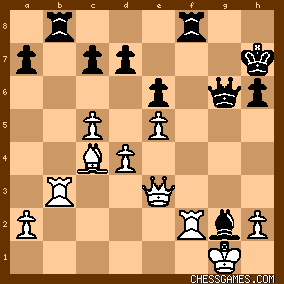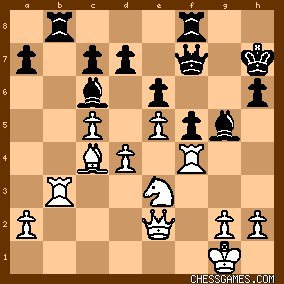|
< Earlier Kibitzing · PAGE 2 OF 2 ·
Later Kibitzing> |
| Jul-19-06 | | tonsillolith: About the note on move 7, why must 7...Ne4 be prevented? What makes it such a good move? |
|
| Jul-19-06 | | CapablancaFan: <tonsillolith> It was important to play 7.Nbd2 to effect exchanges in the event of 7...Ne4(Which Capa actually played). Now Capa has a dominating position in the center with his knight.Also, even if this knight is exchanged, now the dangerous diagnol is opened up for Capa's bishop on b7. How dangerous is this bishop? See move ...31. |
|
| Dec-29-06 | | notyetagm: 31 ... ♗xg2!! is a brilliant tactical shot by Capablanca. Position after 31 ... ♗xg2!!:

click for larger viewThe point is that 32 ♖xg2?? allows the mating sequence 32 ... ♕b1+! 33 ♖xb1 ♖xb1+ 34 ♗f1 ♖fxf1#, shown below: 
click for larger viewCapablanca really was a supreme master of tactics.
31 ... ♗xg2!! 32 ♖xg2?? <deflection from f1-blocking square> 32 ... ♕b1+! 33 ♖xb1 ♖xb1+ 34 ♗f1 ♖fxf1# |
|
| Dec-29-06 | | dakgootje: game worth to become gotd...
ps: still not all that concinved 7. ...Ne4 should be prevented ;-) |
|
| Dec-30-06 | | Fisheremon: <chessgames.com> Interesting game played in 1922 with ECO Yusupov-Rubinstein System ?! |
|
| Mar-03-08 | | Karpova: This is important for the game:
http://www.chessbase.com/newsdetail...
After 26.Bxf4

click for larger viewTwo versions exist:
<Version 1 (Burn’s column in The Field, 19 August 1922, page 271, Maróczy’s tournament book, published in summer 1923, and most subsequent sources): 26…Nxf4 27 Rxf4 Kh7 28 Ne3 Bg5.> <Version 2 (The Times, 5 August 1922, page 14, and most other 1922 sources): 26…Kh7 27 Ne3 Nxf4 28 Rxf4 Bg5.> If version 2 was correct than Morrison didn't miss a win on move 28 and Capablanca didn't blunder on move 27. 26...Kh7 27.Ne3 Nxf4 28.Rxf4 Bg5 [see diagram]

click for larger view29.Rxf5? Bxe3+ |
|
Mar-31-08
 | | Mateo: <aulero> <<dinesh> After 18.exf6 Nf4 19.Qd1 Nxg2 White is lost.> It seems that <dinesh> was right. Instead of 19.Qd1, 19.Qe3 could be an improvement. |
|
Mar-31-08
 | | Mateo: <Calli: The ending is still bad because of things like 48.Rf1 Rh3 (threat Bd3) 49.Ra1 a2! 50.Bxc6 Rxh4 51.Bg2 Bb1 and Black should win in the long run.> Your variation is nice (49...a2!), but the final result is not obvious to me after 52.d5 exd5 53.Bxd5. White could also consider 51.Bf3 Bb1 (51...Rxd4 allows 52.Rxa2) 52.d5 exd5 53.Bxd5 which leads to your variation. |
|
Mar-31-08
 | | Mateo: <Calli: The ending is still bad because of things like 48.Rf1 Rh3 (threat Bd3) 49.Ra1 a2! 50.Bxc6 Rxh4 51.Bg2 Bb1 and Black should win in the long run.> Maybe an improvement for White could be the strange looking 51.Kd2! (the idea is to bring the King to the queen side). After 51...Rxd4+ 52.Kc3 Rd3+ 53.Kb4 Rd2 54.Bb5, White should have some drawing prospects. But it is very complicated of course. |
|
| Sep-14-08 | | Karpova: Now there's a feature article by Edward Winter on this game and its two versions (in this database it's version 1): <Morrison v Capablanca, London, 1922> http://www.chesshistory.com/winter/... |
|
| Oct-01-08 | | vikinx: <32 ... b1+! 33Rxb1 Rxb1+ 34Bf1 Rfxf1#>Just for the record, instead of 34. Bf1, White can play 34. Qc1 or Qe1. |
|
| Feb-17-14 | | notyetagm: J S Morrison vs Capablanca, 1922
click for larger view |
|
| Aug-26-17 | | karik: I believe the Winter article clearly indicates that the version 2 is correct. Capablanca didn't do such blunders. Accordingly, Chessgames should fix the score. |
|
Oct-10-18
 | | keypusher: SF finds a very cute draw if White takes the bishop at move 18: 18. exf6 Nf4 19. Qe3 Nxg2 20. Qg5 Qxg5 21. Nxg5 Nf4 (so far Capablanca writing in the <Times>) 22. fxg7 Rf6 (so far Maroczy in the tournament book) 23. c6! dxc6 24. Bc4 Rg6 25. Kh1 Rxg5 26. Bd2 Rg4 27. f3 Rh4 28. Be1 with a repetition. But White was slightly better at move 18, so Morrison was objectively right to prefer 18.Bd2, plus we all got a very interesting game to enjoy. |
|
Oct-10-18
 | | keypusher: <Version 2 (The Times, 5 August 1922, page 14, and most other 1922 sources): 26…Kh7 27 Ne3 Nxf4 28 Rxf4 Bg5.> One other interesting point about Version 2: after 26....Kh7, instead of 27.Ne3, White has 27.Bxd5! Bxd5 28.Rh3, and h6 cannot be defended. Of course Black gets a very strong QB, but he is still in bad shape after 28....Rg8 29.Ne3! Be4 30.Rxh6+ Kg7 31.Ng4! Rh8 32.Rxh8 Kxh8 33.Nf6!. In short, ...Kh7 was a blunder whether it was played at move 26 or move 27. But given that Capablanca used Version 2 in his newspaper report, and given that it's easier to imagine Capablanca and Morrison overlooking 27.Bxd5 in Version 2 than 28.Rxf5 in Version 1, it seems probable that Version 2 is correct. |
|
Oct-16-18
 | | keypusher: According to the silicon, the endgame arising at move 35 was about even; but it was complicated, and it's not surprising that Morrison went astray (37.Rf3 and 44.Ba6 seem to have been particularly bad) and Capablanca got a winning position. Then he too went wrong. Position after 46.Ke2:
click for larger viewHere after 46....Ra2+ 47.Ke3 Ra1,
(a) if the king tries to come over, 48.Kd2 a3 49.Kc3 Rg1 50.Kb3 Rg3+ 51.Ka2 Bd3! wins, since 52.Kxa3 loses the bishop and there is no other defense against ...Bc4+ and a3-a2. (b) 48.Rf2 a3 49.Kf4 Rd1 50.d5 (White has nothing better) Rxd5 51.Ra2 Rd4+ 52.Kg3 Rd3+ 53.Kf4 Kf7 54.h5 Ke7 55.Ba6 Rh3 56.Ra1 Rxh5 and White is running out of pawns, while 57.Rxa3 loses the rook. (c) 48.Bxd7 Re1+ 49.Kd2 a3! 50.Rf3 a2, and again the rook is lost. <Calli> and <mateo>, who don't need engines to do good analysis, contributed some interesting lines after 46....Rc3? 47.Bxd7 a3 48.Rf1! 48....Rh3 49.Ra1 a2 50.Bxc6 Rxh4 51.Bg2 Bb1 and, with his rook imprisoned, it seems like White should lose. But then 52.d5 <mateo> exd5 53.c6 (more accurate than 53.Bxd5) 53...Kf8 54.c7 Rc4 55.Bxd5 Rxc2 56.Bxa2 Bxa2 57.Rxa2=, or 53....d4 54.c7 d3+ 55.Ke3 d2 56.c8/Q d1/Q 57.Qb7+ with a perpetual. |
|
| Feb-03-19 | | HarryP: This is one of my favorite Capa games. |
|
Dec-13-20
 | | MissScarlett: This game is the subject of a correction request advocating for Version 2 (see above), but the presence of Maroczy's notes preclude any simple amendment. |
|
| Dec-13-20 | | Z4all: <Missy> the database really should have both versions, or pick one and include the other as a variation. With proper documentation, of course.
Now... Winter's treatment makes me wonder, given the importance of contemporaneous sources, why just the "other 1922 sources" for version 2? Why is "The Times" given preeminence? Is it the earliest publication? Prestige? Convention? What? E.g. do we know "The Times" reporter was the transcriber / main reporter, and all other 1922 publications working off the wire? Damn it man, list 'em all out - Winter-standard style! That/s what this peep says. |
|
Dec-13-20
 | | MissScarlett: <Why is "The Times" given preeminence? Is it the earliest publication?> The report is from the following day, so there can't be any earlier. The <Morning Post> and the <Standard>, two other London daily papers which one might think could carry the game score, aren't available online for 1922. <keypusher> above assumes the score came directly from Capablanca, but that's not certain. I would assume the organisers issued a daily bulletin. |
|
| Dec-14-20 | | Z4all: Thanks <Missy>. A stupid oversight on my part, not realizing that Capa was contributing to <The Times>. It's not explicitly mentioned in Winter's article, which is a bit of a surprise as concerns picking a version. Still, I wonder if Capa was writing for <The Times> exclusively. And I still wonder about the other sources not enumerated. (I love sources, after all) |
|
Jun-05-22
 | | kingscrusher: I find it interesting that Capablanca seems to have real empathy for what the general public might find the most interesting points of this game - where the sacrifices basically occur in the article at: https://www.chesshistory.com/winter... In studying Capablanca games generally as a major tactician and sacrificial player, I realise quite clearly that I much prefer the playing style of Mikhail Tal. But thought it would be "educational" to take Capablanca extremely seriously. It is great to see he also knows what most of the the public wants - major tactical sacrifices and fireworks :) There is a Tal inside Capablanca as this game shows, but Capablanca indicates the preference for steadily "increasing the pressure" which is understandable, as the problem with fireworks is that they don't really guarantee an advantage if the opponent is resourceful a lot of the time. And then the possibility of intensifying pressure in a "dryer" manner is often lost. Dryness is also with Magnus Carlsen but it is the meat and potatoes of winning chess. |
|
| Jan-20-25 | | nikrj: A masterpiece by Capablanca. The Cuban genius was in peak form here. |
|
| Jan-20-25 | | FM David H. Levin: <<dakgootje>: [...snip...] ps: still not all that concinved 7. ...Ne4 should be prevented ;-) > I think that the main benefit of 7...Ne4 is to facilitate 8...f5, which increases Black's control of the e4-square and space on the kingside (that is, along the f-file and the second rank). This sequence makes it difficult for White to effectively prepare e4... because several pieces would likely be exchanged (thereby diluting the force of White's attack) and Black would have more room on the kingside in which to maneuver (than if he hadn't played ...f5). If White had prevented 7...Ne4 by playing Maroczy's suggested 7. Nbd2, Black could have sought space elsewhere, by playing ...c5. Although Black should still be fine, my guess is that it would probably take him longer to demonstrate equality than in the game continuation. |
|
| Jan-22-25 | | visayanbraindoctor: This ability of Capablanca to see (very rapidly too) such combinations almost all other chess players would not even think about that makes me believe (among other reasons) why in my opinion he was the strongest chess player in history in his prime. It's not only this game. Many of the games of the early Capablanca were so complicated almost everyone would have made losing errors or incorrect combinations. The early Capablanca did NOT shirk from bizarre complicated positions. Yet for a long time, the prime Capa never made a losing error, and saw all these little combinations quickly and easily. It was impossible to 'outcombine' him in his prime. (Even tactical players like Alekhine and Marshall found that out.) |
|
 |
|
< Earlier Kibitzing · PAGE 2 OF 2 ·
Later Kibitzing> |





































